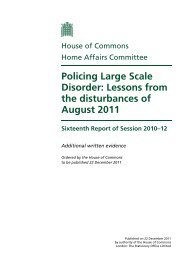Vulnerability and involvement in drug use and ... - Sex Work Europe
Vulnerability and involvement in drug use and ... - Sex Work Europe
Vulnerability and involvement in drug use and ... - Sex Work Europe
You also want an ePaper? Increase the reach of your titles
YUMPU automatically turns print PDFs into web optimized ePapers that Google loves.
<strong>Vulnerability</strong> <strong>and</strong> <strong><strong>in</strong>volvement</strong> <strong>in</strong> <strong>drug</strong> <strong>use</strong> <strong>and</strong> sex work<br />
50<br />
T h e re was no significant diff e rence between those us<strong>in</strong>g services <strong>and</strong> those not us<strong>in</strong>g<br />
s e rvices with re g a rd to re p o rted number of sexually transmitted <strong>in</strong>fection (STI) diagnoses<br />
(29% <strong>and</strong> 26% respectively reported receiv<strong>in</strong>g two or more STI diagnoses; the rema<strong>in</strong><strong>in</strong>g<br />
participants reported never or only once receiv<strong>in</strong>g a diagnosis) 5 .<br />
Service impact on problematic <strong>drug</strong> <strong>use</strong><br />
As noted above, participants contacted <strong>drug</strong> services for a range of reasons, <strong>in</strong>clud<strong>in</strong>g for<br />
t reatment for problem <strong>drug</strong> <strong>use</strong>. Half (n=53; 53%) of participants with experience of<br />
p roblem <strong>drug</strong> <strong>use</strong> re p o rted receiv<strong>in</strong>g <strong>drug</strong> treatment. Over one-quarter (n=17; 29%) of<br />
participants with a current <strong>drug</strong> problem reported receiv<strong>in</strong>g <strong>drug</strong> treatment <strong>in</strong> the last month.<br />
Among participants with experience of problem <strong>drug</strong> <strong>use</strong> <strong>and</strong> experience of <strong>drug</strong> treatment,<br />
four-fifths (n=42; 79%) reported hav<strong>in</strong>g a current <strong>drug</strong> problem, while one-fifth (n=11; 21%)<br />
reported no longer hav<strong>in</strong>g a <strong>drug</strong> problem. Almost all (n=39; 93%) of the participants who<br />
had both received <strong>drug</strong> treatment <strong>and</strong> had a current <strong>drug</strong> problem were sex work<strong>in</strong>g at the<br />
time of <strong>in</strong>terview <strong>in</strong> the sector they had worked ma<strong>in</strong>ly <strong>in</strong> s<strong>in</strong>ce start<strong>in</strong>g. The rema<strong>in</strong><strong>in</strong>g three<br />
participants had stopped sex work. Those who had received <strong>drug</strong> treatment <strong>and</strong> reported<br />
hav<strong>in</strong>g a past but not a current <strong>drug</strong> problem fell <strong>in</strong>to three groups with respect to their<br />
<strong><strong>in</strong>volvement</strong> <strong>in</strong> sex work. Five (46%) had stopped sex work, four (36%) had cont<strong>in</strong>ued sex<br />
work<strong>in</strong>g but moved to a different sector, <strong>and</strong> two (18%) had cont<strong>in</strong>ued sex work<strong>in</strong>g <strong>in</strong> the<br />
sector they had worked ma<strong>in</strong>ly <strong>in</strong> s<strong>in</strong>ce start<strong>in</strong>g.<br />
For the five participants who no longer had a <strong>drug</strong> problem <strong>and</strong> had stopped sex work,<br />
exit<strong>in</strong>g from sex work was enabled by their exit<strong>in</strong>g from problem <strong>drug</strong> <strong>use</strong>. For all these<br />
p a rticipants, <strong>in</strong>tervention was key <strong>in</strong> this process; more o v e r, successful <strong>in</strong>tervention always<br />
<strong>in</strong>volved residential treatment (either <strong>in</strong> prison, <strong>in</strong> a community rehab or <strong>in</strong> hospital). The<br />
six participants who no longer had a <strong>drug</strong> problem but were still sex work<strong>in</strong>g described<br />
the end of their <strong>drug</strong> problems as due to their own determ<strong>in</strong>ation rather than <strong>in</strong>terv e n t i o n<br />
f rom serv i c e s .<br />
Integration of services for sex workers<br />
Dur<strong>in</strong>g fieldwork many hard-work<strong>in</strong>g professionals were encountered with a great deal of<br />
experience <strong>in</strong> work<strong>in</strong>g with <strong>drug</strong> <strong>use</strong>rs <strong>and</strong> sex workers. Several of them wanted to<br />
5 See Appendix A – Statpo<strong>in</strong>t 5.
















